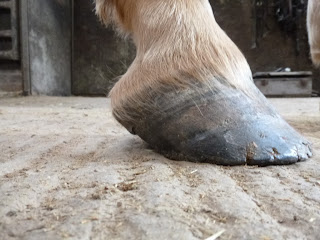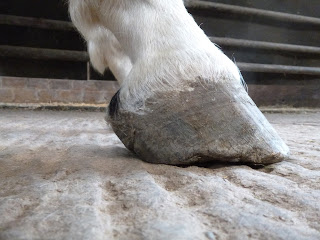Most of us first came across the term "navicular" in a context of dreadful doom and gloom. Once a horse was lame and navicular was diagnosed, the outlook supposedly was pessimistic.
The article below, from Dick Vet, is characteristic in describing navicular syndrome as a "chronic degenerative disease" - whose progress might be slowed but would inevitably worsen over time.
Of course, as those of us who have barefoot horses know, the types of long term weakness and pathology which are found on x-ray and MRI in "navicular" horses can, in fact, be improved and healed in the majority of cases.
However, although most horses are first diagnosed via x-ray or MRI, its rare for horses with a navicular diagnosis to undergo x-ray or MRI after they have come sound following barefoot rehab...but there are a few horses for whom its been done.
This is one of a set of radiographs taken of my old horse, Ghost, aged 23. He'd been diagnosed with navicular syndrome on the basis of x-rays which showed navicular bone damage aged 16 or 17.
He'd been in bar shoes for 2-3 years and became progressively lamer until, aged 19, I tried barefoot as a last resort.
By the time this plate was taken, in 2008, he'd been barefoot and back in work for 4 years. There was no longer any discernible bone damage, according to the vet, even though the 2008 plates were digital, much higher quality than the original x-rays and should have shown up every last blip.
Ghost lived til he was 25 yrs old and was sound and in full work till the end. He was eventually put down due to extensive melanomas which were seriously affecting his gut.
Dexter's story is similar. Having been diagnosed with navicular and given a 5% chance of returning to any sort of work in 2007 he came here early in 2008 and was successfully rehabbed barefoot, despite having dreadful TB feet.
Dexter had an MRI in 2008 during his last week of rehab here and it showed a healed DDFT lesion. Over 5 years later Dex is still going strong, hunting and jumping.
The same result occurred when another ex-rehab had an MRI, again a few months after rehab.
The collateral ligament injury which was evident on his initial MRI had healed and - even more interestingly - there appeared to be new bone growth being laid down in the navicular bone, which had also shown damage. Again, this horse went back to full work, hunting and jumping.
Of course these are only a small number individual horses -
but the findings following rehab are consistent.
I was reminded of this over the weekend when I had an update on another ex-rehab who unfortunately suffered a bout of laminitis at the start of the summer. That was bad luck but its under control and I am sure he will be back on track in no time.
The interesting thing was the vet's comment as she re-xrayed his feet. He'd had an MRI before his rehab which showed navicular bone damage, DDFT and impar ligament damage. Of course the tendons and ligaments couldn't be assessed on x-ray but she did say that: "
the navicular bone was much improved and showing signs of new bone formation". Not bad as he only went home at the start of this year.
So why has navicular syndrome been labelled as a "degenerative disease"? The clue may lie further on in the same Dick Vet article.
"Unfortunately navicular syndrome is not curable due to its chronic and degenerative nature. Therapy is structured around corrective trimming and shoeing...A variety of shoes may be used, for example egg bar shoes or raised heel shoes, but the essential feature is the provision of adequate length of shoe underneath the heel to give good support."
This statement, I must say, rings true with me and with many other owners whose horses have been shod with bar shoes or wedges in an attempt to alleviate the symptoms of navicular syndrome. My experience with remedial shoes is that the horse improves for a short period but over the medium and long term the lameness recurs and worsens as the palmar hoof deteriorates.
By contrast, the 4 barefoot rehab horses who've had investigation post-rehab all show healed tendons, ligaments and even bones.
Perhaps its rational to conclude from the radiographs and MRIs of these 4 horses that degeneration
isn't inevitable.
Perhaps the reality is quite the opposite: tendons, ligaments and even bone
can repair provided you give the palmar hoof a chance to strengthen and heal - and that's best done out of shoes.
Surprised? Not really....





























































